WHEN New York City's World Trade Center twin towers were destroyed in a terrorist attack on Sept 11, 2001, one may have wondered how the city would rebound in the face of the unthinkable tragedy.
On Monday, the world got the emphatic answer when the city's latest skyscraper opened on the same site that witnessed such horrors more than 13 years ago.
Here are some things to know about the reopened One World Trade Center:
What are some of the features of the new building?
1. The new building is part of a complex of six buildings and a 9/11 memorial and museum.
2. It was built on the 6.5ha site at a cost of US$3.8 billion (S$4.9 billion).
3. It has 104 storeys and has a height of 540m, or 1,776 feet. The figure is meant to represent the year of the United States' independence.
4. The building is deemed to be the tallest in the United States and the Western Hemisphere, but this is a matter of some debate, which centres on whether its steel spire on top should be counted in its height. If it is counted, the building outranks Chicago's Wills Tower, which is 1,451 feet tall. Most New Yorkers unsurprisingly claim One World Trade Center to be the tallest, while Chicagoans point to the fact that the observation deck of the Wills Tower is actually higher up in the sky than the highest occupied floor of One World Trade Centre.
5. The building was originally slated to be named the Freedom Tower, but its owner, the Port Authority of New York and New Jersey, changed its name to One World Trade Center in 2009 as it was "easiest for people to identify with".
6. The building has a sustainable design at its core that integrates renewable energy, interior daylighting, the reuse of rainwater and recycled construction materials.
7. Sightseers will be able to get a good look at the breathtaking view of the city from the skyscraper with the opening next year of an observation deck on floors 100 to 102 of the building.
8. A transportation hub near the site will be costliest in history, costing US$3.75 billion. Designed by Spanish architect Santiago Calatrava, its price tag was questioned by public officials and the media.

Who are some of its tenants?
1. At least one famous fashion icon will be a denizen of the building. Ms Anna Wintour - the editor of Vogue magazine who is so admired and feared that she inspired a novel and film, The Devil Wears Prada, starring Meryl Steep - will move into the 25th floor. Another editor of a famous magazine, Vanity Fair editor Graydon Carter, will be on the 41st floor.
2. The two magazines are published by media conglomerate Conde Nast, which was the first to move into the building, with an initial 175 employees starting work there on Monday. The company, which will be headquartered there, will occupy floors 20 to 44. About 3,000 more employees will move in early next year.
3. 60 per cent of the building has already been leased out. Some of its tenants will be advertising firm Kids Creative, the China Centre, a trade and cultural facility, and the US government's General Services Administration.
Others include stadium operator Legends Hospitality, investment adviser BMB Group and Servcorp, a provider of executive offices.
Why is the building "the safest in America"?
Due to the desire to avoid the tragic fate of its predecessor, the building's architects Skidmore, Owings & Merrill consulted the Federal Bureau of Investigation, the Department of Homeland Security and local police forces for its design.
The building features dense fireproofing, biochemical filters, extra-wide pressurised stairs to allow people to exit while firefighters move in, multiple back-up emergency lighting, and concrete protection for mechanical systems, including all sprinklers. The stairwells were built with a concrete core.
It has a 20-storey fortress-like base of steel-reinforced concrete that contains mostly building systems and few offices. A total of 24 steel columns make up its perimeter, each of them 18.3m long and weighing 70 tonnes. Its elevators and stairwells are encased by a concrete core of more than 91cm thick. The building includes 45,000 tonnes of structural steel and 159 million litres of concrete in total.
Mr John Duffy, director of policies and controls at Conde Nast, said it is "probably indestructible".
Mr Patrick Foye, executive director of the Port Authority of New York and New Jersey, the building's owner, called it "the most secure office building in America".
Chief architect T.J. Gottesdiener said that the firm had to go beyond the city's existing building codes to make the building as terror attack-proof as possible - much stronger than the original twin towers.
"If my son told me he had a job in the trade center Tower 1, I would have no qualms about him being there," Mr Gottesdiener said.
What were the problems encountered in constructing the building?
After the 9/11 attacks, opinions were divided as to what should be done with the site. Some wanted the twin towers rebuilt. Others wanted the whole site to be a memorial, with nothing built there. Finally, the current plan was agreed on, but its owner scrapped plans to rebuild a few attractions of the site that were destroyed, attracting outrage.
A competition called to design the memorial was won in 2004, and the official start of construction for the complex was on March 2006, when workers arrived at the site to begin surveying work for the memorial and museum.
The construction was not all smooth sailing. It was beset by delays, litigation, disputes and power plays among a cast of stakeholders that included political officials, residents, architects and advocates for the families of the 9/11 attack victims. All three different designs of the building were met with much criticism, together with the monetary expense and completion delays. Mr Blair Kamin, an architectural critic for the Chicago Tribune, recently called the building a "bold but flawed giant".
A major cause for delay was an order to redesign the whole main building in 2005 when the New York Police Department said it could not be protected from a truck bomb. Investor and developer Larry Silverstein and a syndicate of insurers battled in court for about six years before reaching a settlement in 2007. The credit crisis of 2008 and 2009 also hampered financing of office construction.
The planned performing arts centre, originally to be designed by Frank Gehry, is also facing delays after Mr Gehry's design was scrapped and its progress hampered by fund-raising issues.
The opening of a memorial museum at the site also attracted controversy as religious advisers criticised its depiction of Al-Qaeda for being linked too closely to Islam. Some 9/11 families were upset about a lack of dignity in transferring thousands of unidentified remains of victims to an underground repository at the site.
Another bone of contention was the gift shop, opposed by those who believe that there should be no commercialisation of what is a site of mass murder.
An Islamic cultural centre that opened in 2011, two blocks from the site, also attracted mass protests in the city by people who felt that the site should not house a mosque.
Sources: Bloomberg, AFP, Reuters, New York Times, Washington Post, American Society of Civil Engineers







